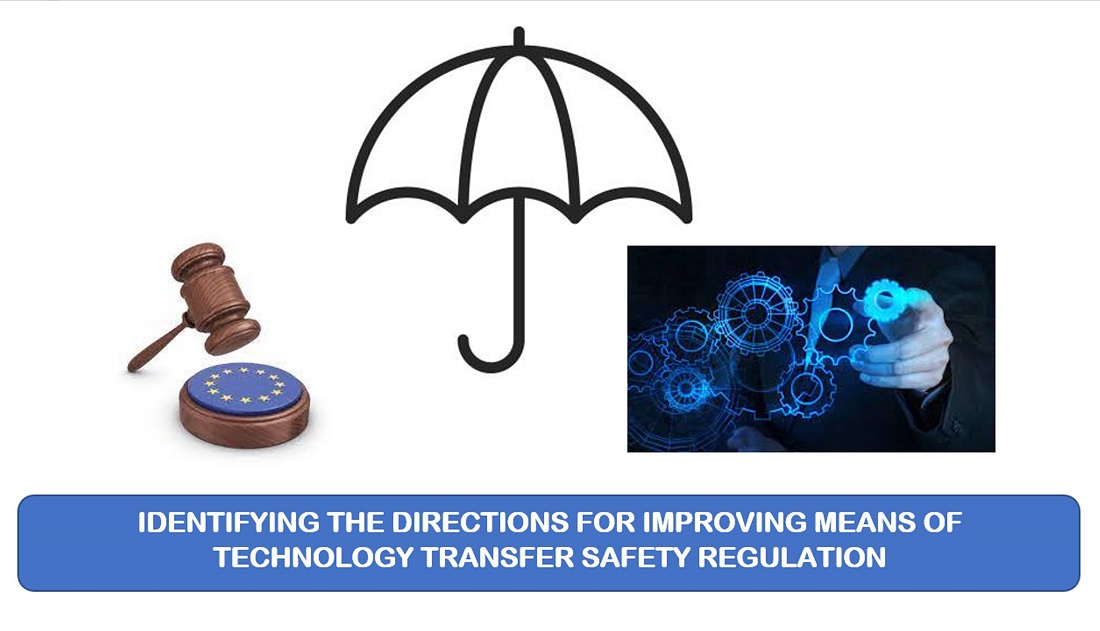Визначення напрямків вдосконалення засобів регулювання безпечності трансферу технологій
DOI:
https://doi.org/10.15587/1729-4061.2023.290116Ключові слова:
трансфер технологій, безпечність технологій, захист довкілля, екологічна, техногенна, промислова безпекаАнотація
Об’єктом цього дослідження є визначення сутності та способів вдосконалення регуляторних заборон екологічної, промислової техногенної безпеки в межах трансферу технологій. Узагальнено існуючі підходи до визначення та нормативної фіксації способів і прийомів формування вимог безпечності технологій. Встановлено, що існуючі підходи до визначення не відповідають в повній мірі потребам і державного регулювання і вимогам суб’єктів трансферу технологій. Обґрунтовано доцільність вдосконалення існуючих способів визначення екологічної, промислової та техногенної безпечності технологій. Запропоновано визначення безпечності технології на рівні узагальнених нормативних конструкцій, під якими розуміється заборона на введення в обіг технологій, які спричиняють непоправні зміни в оточуючому середовищі, несуть в собі загрозу спричинення шкоди життю чи здоров’ю, або масової майнової шкоди внаслідок її належного використання. Обґрунтовано доцільність введення зазначеної нормативної регуляторної конструкції до міжнародних договорів і угод, а також до регуляторних актів національного законодавства. Також, було сформовано напрямки вдосконалення чинних міжнародних угод і договорів у сфері трансферу технологій шляхом, введення до їх змісту вимог щодо екологічної, промислової, техногенної безпеки технологій, як обов’язкової умови введення її в обіг.
Дослідження спрямовано на формування загальних теоретичних засад удосконалення системи критеріїв ідентифікації безпечності у сфері трансферу технологій. Сформовані результати дослідження можуть бути використані при формуванні міжнародних нормативних актів, актів національного законодавства та слугувати підставою для подальших наукових досліджень з цих питань
Посилання
- Čižiková, A. (2023). Aktivity na poli transferu technológií v KTT SAV. Transfer Technológií Bulletin, 1, 44. doi: https://doi.org/10.52036/ttb2023144
- Paniccia, P., Baiocco, S. (2018). Co-Evolution of the University Technology Transfer: Towards a Sustainability-Oriented Industry: Evidence from Italy. Sustainability, 10 (12), 4675. doi: https://doi.org/10.3390/su10124675
- Fang, H., Yang, Q., Wang, J., Liu, X. (2021). Coupling Coordination between Technology Transfer in Universities and High-Tech Industries Development in China. Complexity, 2021, 1–16. doi: https://doi.org/10.1155/2021/1809005
- Świadek, A., Szopik-Depczyńska, K. (2014). Changes In Innovation Activity In Regional Industrial System In The Context Of Size Of Enterprises In West Pomeranian Province. Folia Oeconomica Stetinensia, 14 (2), 225–238. doi: https://doi.org/10.1515/foli-2015-0003
- Rasheed, E. K. (2016). A Program Applying Professional Safety Basics in Construction Projects. Journal of Engineering, 22 (4), 1–21. doi: https://doi.org/10.31026/j.eng.2016.04.12
- Soroka, L., Syntichenko, O. (2018). Sustainable Development of “Green” Technologies: Legal Protection of the Ambient Air from Pollutants. Advanced Space Law, 2. doi: https://doi.org/10.29202/asl/2018/2/9
- Bezzubov, D. (2020). Administrative and Legal Forms of Regulation of the Modern Market of Space Services and Technologies. Advanced Space Law, 5. doi: https://doi.org/10.29202/asl/2020/5/2
- Mohr, R. (2020). Law and Technology: Being Human in the World. Law, Technology and Humans, 2 (1), 1–3. doi: https://doi.org/10.5204/lthj.v2i1.1540
- Davydiuk, O., Shvydka, T., Shovkoplias, H., Senyk, Y., Toporkova, M. (2023). Directions for improving the system of guarantees for participants in technology transfer. Eastern-European Journal of Enterprise Technologies, 4 (13 (124)), 16–25. doi: https://doi.org/10.15587/1729-4061.2023.285968
- Agreement on Trade-Related Aspects of Intellectual Property Rights (as amended on 23 January 2017). WTO. Available at: https://www.wto.org/english/docs_e/legal_e/31bis_trips_01_e.htm
- Regulation (EU) 2021/695 of the European Parliament and of the Council of 28 April 2021 establishing Horizon Europe – the Framework Programme for Research and Innovation, laying down its rules for participation and dissemination, and repealing Regulations (EU) No. 1290/2013 and (EU) No 1291/2013 (Text with EEA relevance). Official Journal of the European Union. Available at: https://eur-lex.europa.eu/eli/reg/2021/695
- The Measurement of Scientific, Technological and Innovation Activities. doi: https://doi.org/10.1787/24132764
- Zakon Ukrainy «Pro derzhavne rehuliuvannia diyalnosti u sferi transferu tekhnolohiy» (Vidomosti Verkhovnoi Rady Ukrainy, 2006 r., No. 45, st. 434). Available at: https://zakon.rada.gov.ua/laws/show/143-16#Text
- Zakon Ukrainy «Pro okhoronu atmosfernoho povitria» vid 16.10.1992 r. (Vidomosti Verkhovnoi Rady Ukrainy, 1992 r., No. 50, st. 678). Available at: https://zakon.rada.gov.ua/laws/show/2707-12#Text

##submission.downloads##
Опубліковано
Як цитувати
Номер
Розділ
Ліцензія
Авторське право (c) 2023 Oleksandr Davydiuk, Iuliia Ostapenko, Volodymyr Shekhovtsov, Iryna Sukhodubova, Yurii Senyk

Ця робота ліцензується відповідно до Creative Commons Attribution 4.0 International License.
Закріплення та умови передачі авторських прав (ідентифікація авторства) здійснюється у Ліцензійному договорі. Зокрема, автори залишають за собою право на авторство свого рукопису та передають журналу право першої публікації цієї роботи на умовах ліцензії Creative Commons CC BY. При цьому вони мають право укладати самостійно додаткові угоди, що стосуються неексклюзивного поширення роботи у тому вигляді, в якому вона була опублікована цим журналом, але за умови збереження посилання на першу публікацію статті в цьому журналі.
Ліцензійний договір – це документ, в якому автор гарантує, що володіє усіма авторськими правами на твір (рукопис, статтю, тощо).
Автори, підписуючи Ліцензійний договір з ПП «ТЕХНОЛОГІЧНИЙ ЦЕНТР», мають усі права на подальше використання свого твору за умови посилання на наше видання, в якому твір опублікований. Відповідно до умов Ліцензійного договору, Видавець ПП «ТЕХНОЛОГІЧНИЙ ЦЕНТР» не забирає ваші авторські права та отримує від авторів дозвіл на використання та розповсюдження публікації через світові наукові ресурси (власні електронні ресурси, наукометричні бази даних, репозитарії, бібліотеки тощо).
За відсутності підписаного Ліцензійного договору або за відсутністю вказаних в цьому договорі ідентифікаторів, що дають змогу ідентифікувати особу автора, редакція не має права працювати з рукописом.
Важливо пам’ятати, що існує і інший тип угоди між авторами та видавцями – коли авторські права передаються від авторів до видавця. В такому разі автори втрачають права власності на свій твір та не можуть його використовувати в будь-який спосіб.










